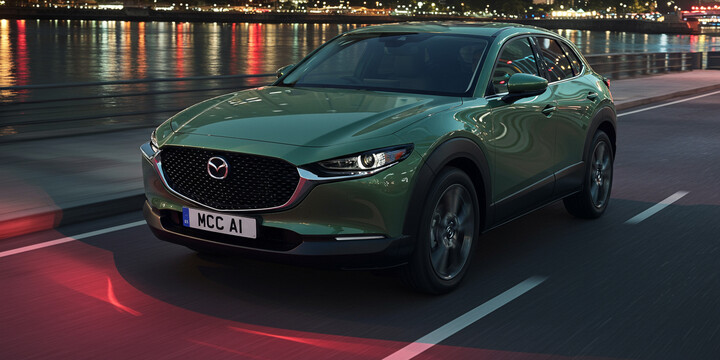
MAZDA CX-30 (2019-) 5DR SUV 2.0 SKYACTIV-G MHEV 122 SS EU6 GT SPORT AUTO6
The MAZDA CX-30 (2019-) 5DR SUV 2.0 SKYACTIV-G MHEV 122 SS EU6 GT SPORT AUTO6 is a stylish and practical compact SUV that has quickly established itself as a popular choice in the UK market. Known for its sleek design, comfortable interior, and efficient performance, this model is ideal for families, daily commuters, or anyone seeking a versatile vehicle with a touch of elegance. Its smooth automatic transmission and mild hybrid system help deliver a refined driving experience while improving fuel economy, making it a smart option for those looking to balance performance with economy.
The MAZDA CX-30 stands out for its engaging driving dynamics and distinctive design, often drawing comparisons to competitors like the Hyundai Kona or Nissan Qashqai. In the used car market, it is recognised for reliable performance, attractive styling, and a reputation for quality. With an average mileage of just under 28,000 miles and a typical private sale value around £18,951, the MAZDA CX-30 offers excellent value for those seeking an SUV that combines practicality, style, and efficiency. Whether used for city driving, family outings, or commuting, the MAZDA CX-30 (2019-) 5DR SUV is a well-rounded choice worth considering.

average use

The data reveals that the most common recent mileage reading for the Mazda CX-30 (2019-) SUV is between 0 and 10,000 miles, accounting for 36.8% of vehicles. The next most frequent mileage range is 20,000 to 30,000 miles at 21.1%. Notably, only 5.3% of vehicles have recorded mileages in the 70,000 to 80,000 miles range, which suggests a tendency for these vehicles to be relatively low-mileage. Overall, the distribution indicates that most Mazda CX-30s on record tend to have low to moderate mileage, with a significant number being relatively new to the road.

vehicle values

The data on private sale valuations for the Mazda CX-30 (2019-) indicates that most vehicles fall within the £10,000 to £20,000 range, with the highest proportion—21.1%—selling between £17,000 and £18,000. Notably, a significant share of the vehicles (over 50%) are priced between £10,000 and £15,000, reflecting strong demand in this bracket. There are relatively fewer cars valued above £20,000, although a notable 15.8% are priced between £23,000 and £24,000. The distribution suggests that the majority of good-condition, private sale Mazda CX-30s tend to cluster around the £10,000 to £18,000 range, with higher prices being less common but still present.

production years

Based on the available data, all recorded Mazda CX-30 vehicles from this sample were manufactured in 2020, accounting for 100% of the sample. This suggests that, at least within this dataset, the vehicles are relatively recent models, with no vehicles from earlier or later years represented. It could indicate that the Mazda CX-30, introduced around 2019, has predominantly been in circulation since 2020.

colour popularity

The data indicates that the most common main paint colour for the Mazda CX-30 (2019-) is grey, accounting for approximately 47.4% of the vehicles. Red is the next most prevalent colour, representing 21.1%, followed by silver and blue, each at 10.5%. Black and white are less common, each at 5.3%. Overall, grey and red dominate the colour preferences, suggesting these are popular choices among buyers of this model.

ownership cycle

The data indicates that a significant majority of Mazda CX-30 vehicles (2019 model year and onwards) have been registered with two keepers, accounting for 47.4% of the sample. The largest portion, 42.1%, has only had a single registered keeper, which could suggest relatively lower mileage or a recent acquisition. Additionally, 10.5% have had three or more keepers, which might suggest higher turnover or earlier ownership changes. Overall, the vehicle appears to have stable ownership trends, with most cars remaining with the same owner for at least the first few years.

engine choices

The data indicates that all MAZDA CX-30 models from 2019 onwards in this sample are equipped with a 2.0-liter engine capacity. Additionally, the entire sample exclusively uses petrol as their primary fuel type. This suggests that the 2.0-litre petrol engine is standard for this model and there are no variations with alternative fuels or different engine sizes within the data provided.












